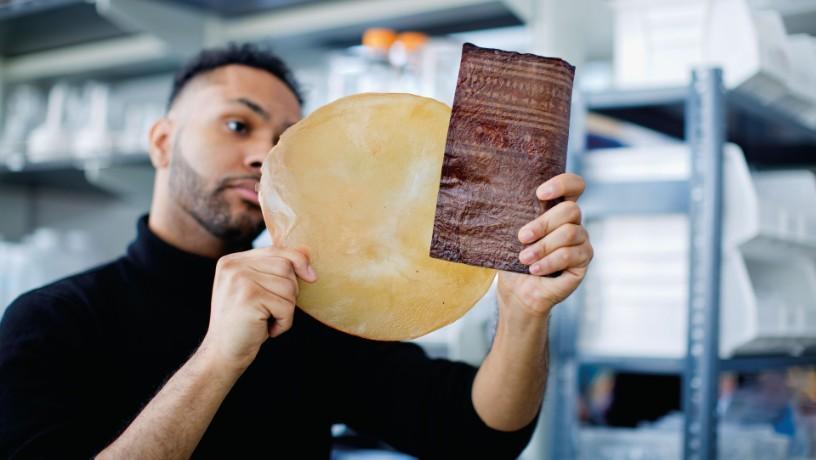5 Energy-saving Innovations
Researchers at Columbia Engineering are developing new technologies to increase efficiency and reduce our need for dirty energy and toxic materials.
During Climate Week NYC, we’re spotlighting some of the ways Columbia Engineers are building a greener world. From energy-efficient radiators to planet-friendly fashion, these five technologies show how breakthroughs in the lab can have a concrete impact in the fight against climate change.
1. Driving Farther with Less Energy

Matthias Preindl (right) and Wesley Pennington discuss software-defined power electronics in MPlab. Credit: Jane Nisselson/Columbia Engineering.
Electric vehicles lose a lot of energy through inefficient power conversion. Associate Professor Matthias Preindl, of electrical engineering, has partnered with tech startup Tau Motors to develop next-generation power conversion technologies for the company’s revolutionary automotive platform.
Learn more about this exciting collaboration between researchers and an industry partner.
2. Slashing the Energy Needed to Keep Legacy Buildings Warm

Marshall Cox PhD’13 founded Kelvin as a student at Columbia Engineering.
Columbia Engineering alumnus Marshall Cox PhD’13 spent his first three winters at Columbia throwing open the window to cool down his boiler-heated dorm room. That experience inspired him to invent a series of products that make steam-powered radiators more energy efficient. The startup he founded on campus, now called Kelvin, recently closed $30 million in Series A funding. The company has retrofitted more than 15,000 buildings across the Northeast.
Read about the intelligent HVAC company and its growing roster of climate solutions.
3. High-performance Computing without Exponentially Higher Carbon Emissions

Photonic transmitter chip mounted on a printed circuit board with electrical and fiber optic connections. Credit: Lightwave Research Laboratory/Columbia Engineering
Professor Keren Bergman of electrical engineering led a team that developed an energy-efficient method for transferring massive quantities of data over fiber-optic cables inside the data centers and high-performance computers that run artificial intelligence programs.
“What this work shows is a viable path towards both dramatically reducing the system energy consumption while simultaneously increasing the computing power by orders of magnitude, allowing artificial intelligence applications to continue to grow at an exponential rate with minimal environmental impact,” Bergman said.
Explore this groundbreaking achievement.
4. Designing Energy Markets that Balance Low Emissions and Affordable Energy

"Power Grid" by Ashwin John is licensed under CC BY-SA 2.0.
With wind and solar providing an ever-growing percentage of electricity to the grid, utilities across the country are turning to private companies to store energy when it’s cheap and abundant and sell it when the demand for energy exceeds the supply. These complex and unpredictable energy markets must be designed with a high level of sophistication to benefit society.
Bolun Xu, assistant professor of earth and environmental engineering, is a leader in developing models to understand these markets and the underlying physical systems.
Dig deeper into this cutting-edge modeling research.
5. Manufacturing Textiles with Less Energy and Fewer Harmful Chemicals

Romare Antrobus, PhD student and co-lead author of the study, examining a sample of the compostable bioleather made in Schiros’ lab at FIT, and characterized at the Lu lab. Credit: John Abbott/Columbia Engineering
The textile industry is responsible for 10% of global carbon emissions, and the cattle industry is the main driver of deforestation. Researchers at Columbia Engineering have developed a method for manufacturing a leather substitute made from microbial nanocellulose.
“Our bioleather represents a breakthrough not only for textiles but shows other industries how to explore a sustainable manufacturing process to engineer regenerative materials,” said Helen Lu, professor of biomedical engineering and senior vice dean of faculty affairs and advancement at Columbia Engineering
Get details about this exciting new material and the pair of textile startups that began in the same research group.
